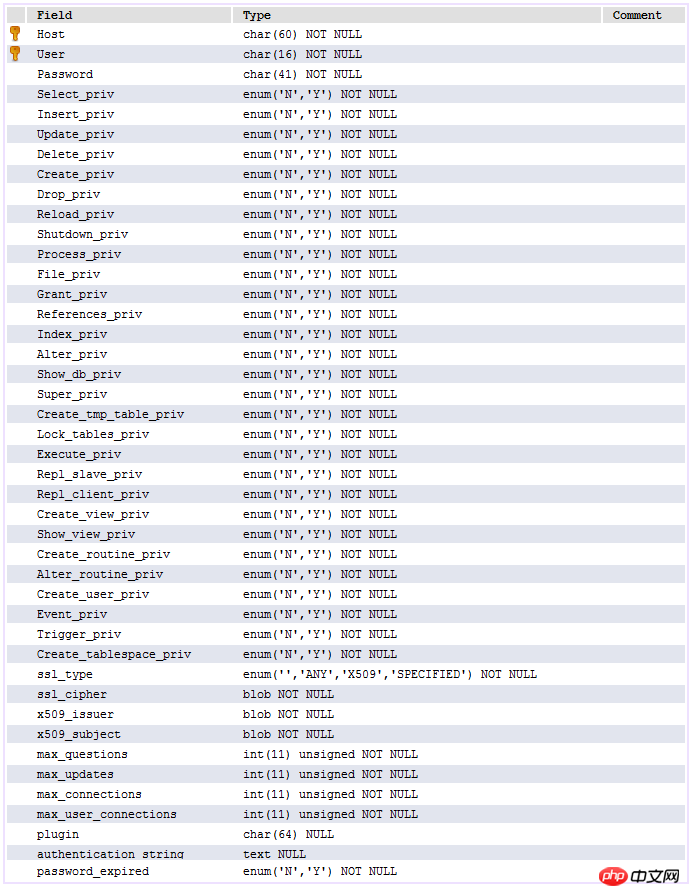Home >Database >Mysql Tutorial >Detailed introduction to permission management in MySQL
Detailed introduction to permission management in MySQL
- 黄舟Original
- 2017-03-01 14:10:011857browse
Permission Management
The MySQL permission system authenticates through the following two stages:
Perform identity authentication on connected users. Legal users pass the authentication, and illegal users refuse to connect.
Grant corresponding permissions to legal users who have passed the authentication. Users can perform corresponding operations on the database within the scope of these permissions.
In the permission access process, it mainly involves the user table and db table under the mysql database. The data structure of the user table is as follows:
The data structure of the db table is as follows:
Description of the table: It contains user columns, permission columns, security columns and resource control columns. The most frequently used ones are the user column and the permission column. Permissions are divided into normal permissions and management permissions. Operations of ordinary permissions user database such as select_priv, insert_priv, etc. Management permissions are mainly used to manage database operations, such as process_priv, super_priv, etc.
When a user connects, the access process of the permission table:First determine the connected IP and user from the three fields of host, user and password in the user table Whether the name and password exist in the table, if they exist, the verification is passed, otherwise the connection is refused.
After passing the authentication, obtain the database permissions in the order of the following permission table: user->db->tables->priv->columns_priv. Global permissions cover local permissions. For example, if a user has select permission in the user table, then he will have select permission on all columns in all tables in all data.

Detailed description of permission search: When the user passes permission authentication, when allocating permissions, the permissions are allocated in the order of user->db->tables_priv->columns_priv, that is, the permissions are checked first. Table user, if the corresponding permission in the user table is Y, then all database permissions corresponding to the user are Y, and db, tables_priv, and columns_priv will no longer be checked; if it is N, the user's specific database permissions will be searched in the db table. , if you get the Y permission in the db, you will not be searching. Otherwise, you will check tables_priv to see the specific table permissions corresponding to the database. If it is Y, you will not be searching. Otherwise, you will be checking the columns_priv table to see the corresponding specific column permissions. This is important when we grant user permissions.
Account management
Create user
To create a user, you can use grant syntax to create or directly operate the user table.
Method 1:
Directly operate the use table
insert into user(Host,User,Password) values(“127.0.0.1 ","test",password("51testit"));
Method 2:
Format CREATE USER 'username'@'host' IDENTIFIED BY 'password';
eg:CREATE USER 'test'@ '127.0.0.1' IDENTIFIED BY '51testit'; 
After creation, log in as follows: 
MySQL encryption method: MYSQL323 encryption generates a 16-bit string. What survives in MySQLSHA1 is a 41-bit string, of which is not added to the actual password operation. Through observation, many users carry "", and the "*" is removed during the actual cracking process. In other words, the actual number of digits in the password encrypted by MySQLSHA1 is 40 digits.
Host field description
The Host value can be the host name or IP number, or locahost represents the local host.
You can use wildcard characters "%" and "_" in front of the host column value. "%" means matching any host. An empty Host value is equal to "%". For example, "%.myweb.com" matches all hosts in all mysql.com domains. The case is as follows:
| Host | User | Analysis |
|---|---|---|
| myweb.wang | pps | pps, connect from myweb.wang |
| pps | pps, connect from any host | |
| ” | Any user, connect from any host | |
| pps | pps, connect from 122.164.35.127 | |
| pps | pps, connect from any host on 122.164.35. type subnet |
##Permissions |
Permission Level |
Permission Description |
| CREATE | Database, table or index | Create database , table or index permission |
| ##Database or table | Delete database or table permissions | |
##Database, table or saved program |
Grant permission options |
REFERENCES |
Database or table |
|
ALTER |
| ##Table | Change the table, such as adding fields, indexes, etc. | DELETE |
| Table | Delete data permission | INDEX |
| Index permission | INSERT |
|
| Insert permission | SELECT |
|
| Query Permission |
|
UPDATE |
Update Permissions |
||
CREATE VIEW |
View | Create View Permission |
SHOW VIEW |
View |
View View Permission |
ALTER ROUTINE |
Stored Procedure |
Change stored procedure permissions |
CREATE ROUTINE |
Stored procedure |
Create Stored Procedure Permission |
EXECUTE |
Stored Procedure |
Permission to execute stored procedures |
| ##FILE | ##File access on the server hostFile Access Permissions | |
| Server Management | Create temporary table permissions | |
| Server management | Lock table permission | ##CREATE USER |
Server management |
Create User Permissions |
PROCESS |
Server Management |
View process permissions |
##RELOAD |
| ##Server management |
Permission to execute flush-hosts, flush-logs, flush-privileges, flush-status, flush-tables, flush-threads, refresh, reload and other commands
|
REPLICATION CLIENT |
| Replication Permissions | REPLICATION SLAVE |
|
| Replication Permission | SHOW DATABASES |
|
| View database permissions | SHUTDOWN |
|
| Close database permissions | SUPER |
|
| Execute kill thread permission |
| How MYSQL permissions are distributed, that is, what permissions can be set for tables, what permissions can be set for columns, etc. This can be explained from a table in the official documentation:
Permission distribution
Table permissions |
|
Column permissions |
|
Process Permissions |
|
|
|









